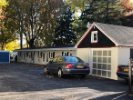News and views for the UB community
Campus News
Niagara Falls Boulevard topic of award-winning graduate preservation studio report

Kerry Traynor (second from left) and members of her award-winning studio accept the "Outstanding Student Project" award. Student attendees, standing to Traynor's left, are Thomas Voigt, Gregory Pinto, Tera Perilli and Marie Myers Shearing. Photo: Courtesy of the New York Upstate APA.
By TYLER MADELL
Published November 19, 2019
A UB urban planning studio that explored the historic value of building typologies along Niagara Falls Boulevard that date back to its origins as a mid-century tourist strip has been recognized by the New York Upstate Chapter of the American Planning Association.
Members of the studio and their instructor, Kerry Traynor, professor of urban planning, accepted the Outstanding Student Project Award at the APA chapter’s annual conference in Rochester last month.
The studio report, “Are We There Yet?” provokes dialogue on the preservation merits of mid-century suburban architectural landscapes — buildings that are not typically considered historical — amidst an ever-evolving set of aesthetic and architectural tastes.
“When people drive down Niagara Falls Boulevard, I doubt that they think of it as significant, or as a collection of buildings that tell an important story about our past,” says Traynor. “The strip malls, the motor motels, the old gas stations, as an example. These buildings have specific typologies that embody a changing way of life in American culture.”
The Boulevard is an iconic commercial corridor in Western New York and served as the main thoroughfare in and out of Niagara Falls for much of the first half of the 20th century, before the dawn of interstates. Students examined the evolution of the Boulevard and patterns of growth from its rural origins to post-war form.
After surveying major portions of the Boulevard and documenting trends, students studied maps, city directories and other primary sources to gain a base knowledge of how the road has developed. The studio then explored extant structures and analyzed precedents that dealt with similar circumstances.
Based on this framework, students developed planning and preservation proposals for future design along the entire Boulevard. These guidelines make the most out of existing structures and implement strategies that allow them to exist in a modern context through the techniques of planning and historic preservation. As the discussion of future use continues, the students focused on locating areas of high historic value and determining ways to establish stronger connections between them.
Among the central recommendations is the creation of a thematic district, “Car Culture on Niagara Falls Boulevard: A Mid-Century Retro District,” that preserves key structures that evoke the automobile culture of the 1950s and 1960s from which the corridor arose.
Higher priority should be given to preserving buildings with significance in more than one area, such as buildings that are local landmarks while also being significant as a remnant of local car culture. Additional design guidelines include preserving structures of specific unique typologies, such as neon signs; encouraging adaptive reuse while maintaining original historic exteriors; and preserving older structures prior to the automobile age that speak to the change over time along the Boulevard.
Looking to the future, the studio report emphasizes maintaining the historic character of the strip, while also transforming it to be more walkable, bikeable and friendlier to transit users. For instance, streetfront mixed-use development with rear parking for cars and streetfront parking for bicycles should be encouraged. Adjacent neighborhoods should be walkable, and houses should have a uniform setback to promote open green space. The report recommends implementing complete streets practices — safe access for all users, including pedestrians, bicyclists, motorists and transit riders — as well as encouraging transit-oriented development. The studio also urges lowering the speed limit, which currently ranges from 45-50 mph across the Boulevard, to calm traffic and support a scenic byway.
Ultimately, the report recommends the region tap into new interest in mid-century resources as historic urban fabric.
“The preservation field’s growing interest in mid-century resources offers an opportunity for the Buffalo-Niagara region to improve one of its most iconic facets,” the report says. “As Niagara Falls Boulevard continues to evolve and urban planning continues to shift away from favoring the automobile, seemingly-mundane structures from the recent past must not be overlooked.
“These resources speak to a critical time in the region’s development, which makes them historically significant.”






![Among the precedents examined by the studio is the Lincoln Motor Court, along Lincoln Highway in Pennsylvania. Lincoln Motor Court is a collection of circa 1940 tourist cabins that have been refurbished and still serve tourists today. Their appeal stems from their rarity, as most other cabins along the Lincoln Highway have vanished. Run by the current owners since the 1980s, the cabins are marketed as “evok[ing] a bygone era of hospitality."](/content/dam/ap/3-News---Events/fall2019/AreWeThereYet/touristcabins.bmp.thumb.100.140.jpg)

